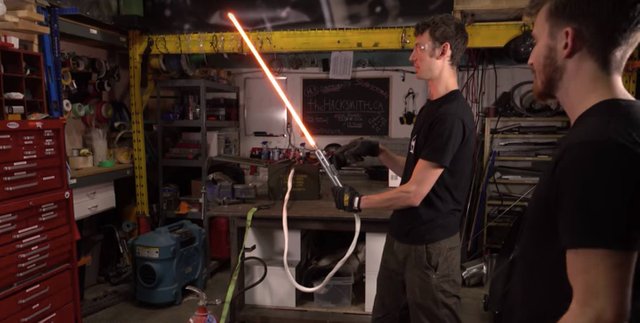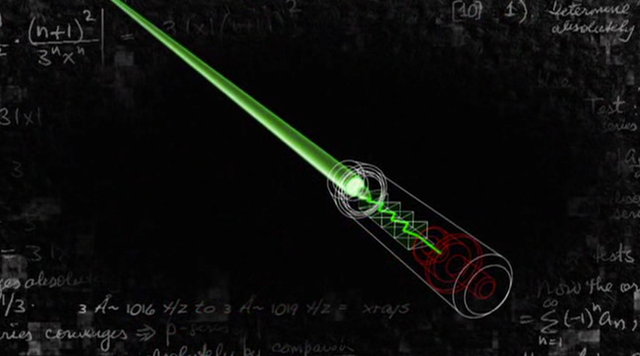Are Real Lightsabers Coming Soon?
Introduction
My fascination with the Star Wars universe has only grown since childhood, despite the newer movies not quite living up to the prestige of the original trilogy. Of course, few things are more iconic in the world of Star Wars than the quintessential Jedi weapon, the lightsaber. Not much could be cooler than owning your very own, so today I will be breaking down the possibility of doing so from a physics perspective.
The History of Fan Made Lightsabers
Ever since the initial release of star wars in the 70’s fans have been mystified by the lightsaber. Naturally, this fascination has led to prototyping and DIY experimentation, often yielding some pretty interesting results.
Allen Pan made his interpretation of a lightsaber that runs off of a methanol and acetone solution. Although this is a far cry from a functioning lightsaber, it is certainly a neat aesthetic and it does burn things.
There are also laser based interpretations that simply emit a powerful laser out the front of the lightsaber hilt. Again, looks cool but in terms of function it is pretty much useless unless stormtroopers are replaced with over inflated balloons.
Finally, one of the coolest models in my opinion, the Hacksmith lightsaber. This is far and away the most powerful of all fan made lightsaber clones, to my knowledge anyways. It incorporates a 2500 degree blade made out of an insulated stainless steel rod wrapped in kanthal wire, a heat resistant metal that does not oxidize when exposed to high temperatures.
The Science Behind a Real Lightsaber
There have been several prevailing concepts in recent years regarding making a real lightsaber or something similar. Many have proposed an arch style blade where there is a plasma that bends across the blade vertically, and returns back to the handle. While certainly cool, this method would not provide any resistance for other lightsabers to clash with, meaning that they would just pass right through each other.
Possibly the most interesting is the design by Dr. Michio Kaku. In his blueprint, there is a lightsaber hilt containing a titanium fan, which sucks in air to be superheated. This creates the plasma used in the blade, which is controlled by a powerful electromagnet. Also inside the handle, there is a telescoping ceramic rod which, upon the press of a button, can be ejected out the front of the hilt. This rod would be drilled along its length, allowing the plasma to effuse outside of the blade. The aforementioned electromagnet would control the flow of the plasma, keeping it within a certain proximity of the rod itself, and creating the infamous lightsaber aesthetic that we know and love today.
The common denominator issue with nearly all of these lightsaber designs is the energy source. To power this design would take nearly 50 MW of energy, enough to power some small towns. Certainly, we will live to see major improvements in battery technology, be it graphene or microsupercapacitors, but the ability to store that kind of heating power in the length of a 6 inch piece of tubing may be forever out of grasp.
A New Hope
So despite the roadblocks I mentioned previously, there is still a possibility that we see a working lightsaber in the future. Researchers at Harvard and MIT produced, for the first time outside of theory, photonic molecules. These molecules don’t behave like any currently recognized state of matter, as the photons deflect each other with remaining linked. This may not sound like a big deal, but our fundamental concept of light is predicated on the concept that light is massless and contains no electric charge.
Researchers were able to get photons to display these characteristics by injecting Rubidium atoms into a vacuum chamber and then reducing the temperature to near 0 degrees Kelvin. When photons were fired into the chamber, experiments were shocked as they proved the Ruberg theory for the first time. This theory states that you cannot excite multiple atoms to the same degree within a certain proximity. The repulsion demonstrated here was even described by the lead researcher as similar to a lightsaber in nature. Still, there is far too little known about this new state of matter to say with confidence that a lightsaber is possible, particularly because there is still an issue of finding a portable power source of the magnitude required for the weapon and containing the energy it emits, which by some estimations would set your clothes ablaze from yards away depending on the design used.
Conclusion
I hope you enjoyed my article, and feel free to comment below about any errors that I made or concepts that I may have overlooked. Have a great day, and be sure to follow me for more content like this.



Still, if you bring a gun to a light saber fight you have an advantage! Ha! Indiana Jones comes to mind. The telescoping ceramic rod concept is intriguing, I can imagine any number of spinoffs of that technology! Great Post! Carry On!
Thanks for reading, and I agree, this stuff is super cool... but I am also a bit of a nerd haha. Hope to see you around and I will definitely continue to read and upvote your posts!
You made a fan of me too....great stuff right there! Keep it up!
Congratulations @jwmcclain! You have completed some achievement on Steemit and have been rewarded with new badge(s) :
Click on any badge to view your own Board of Honor on SteemitBoard.
For more information about SteemitBoard, click here
If you no longer want to receive notifications, reply to this comment with the word
STOP